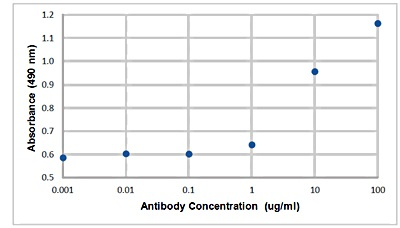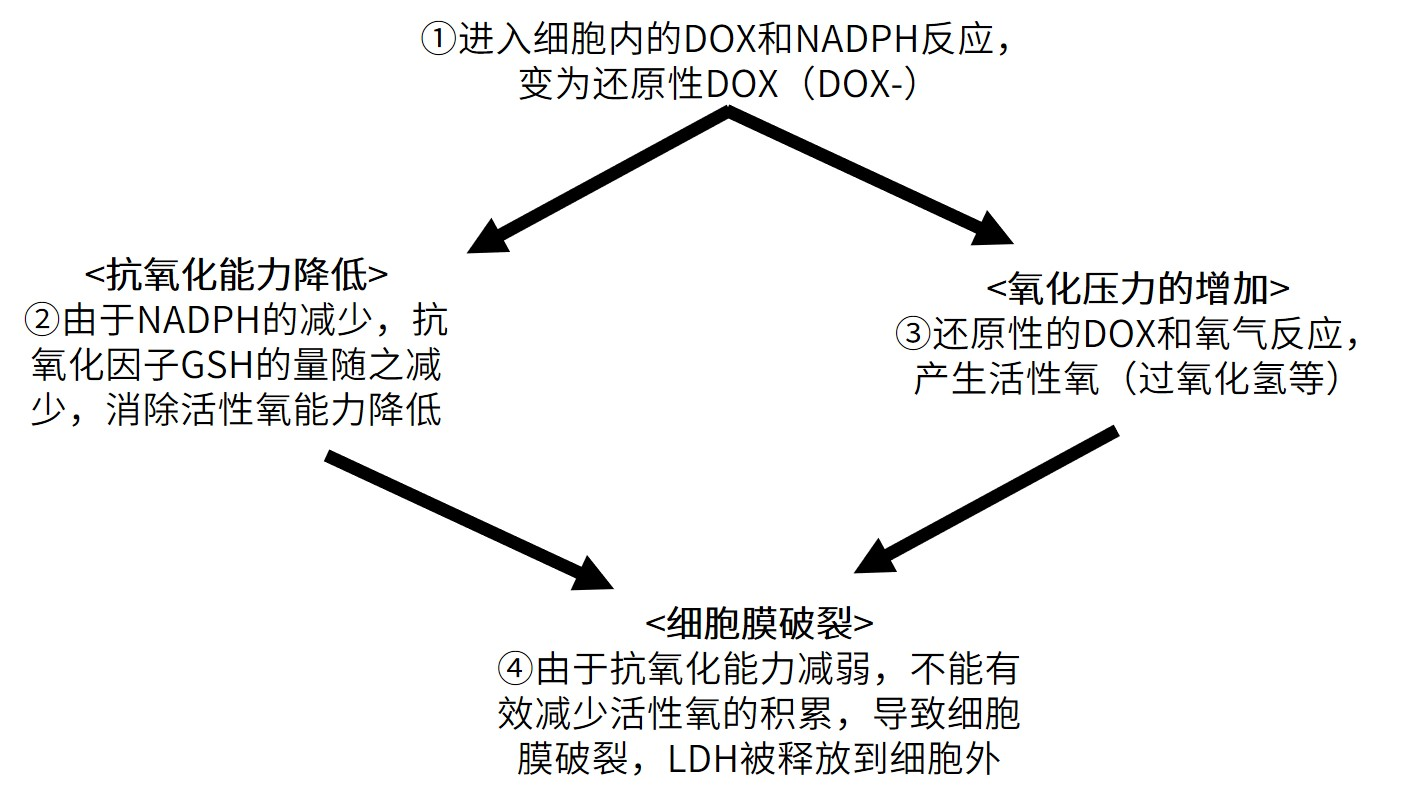货号:CK12
乳酸脱氢酶(LDH)检测试剂盒
Cytotoxicity LDH Assay Kit-WST
储存条件:0-5度保存,避光
运输条件:室温
特点:
- 不与细胞内LDH反应,可直接检测(一步法)或取上清液检测(低损伤法)。
- 更适合Car-T、ADCC、CDC等效靶杀伤实验。
- Working Solution配制后,可稳定保存6个月以上。
- 试剂盒稳定性高,数据重复性好。
- 搭配CCK-8检测,细胞毒性双指标认证。
选择规格:100 tests,500 tests,2000 tests
关联产品:
NO.1. Cell Counting Kit-8 细胞增殖毒性检测
NO.2. Annexin V, FITC Apoptosis Detection Kit 细胞凋亡检测
NO.3. Caspase-3 Assay Kit -Colorimetric 细胞凋亡检测
NO.4. Biotin Labeling Kit – NH2 生物素抗体标记-氨基
NO.5. Cell Counting Kit-Luminescence 细胞增殖/毒性检测
试剂盒内含
| 100 tests |
Dye Mixture
·Assay Buffer
-Lysis Buffer
Stop Solution |
×1
11 ml×1
1.1 ml×1
5.5 ml×1 |
| 500 tests |
· Dye Mixture
-Assay Buffer
-Lysis Buffer
-Stop Solution |
x1
55ml×1
5.5 ml×1
27.5 ml×1 |
| 2000 tests |
-Dye Mixture
·Assay Buffer
Lysis Buffer
-Stop Solution |
x4
55ml×4
5.5 ml×4
27.5 ml×4 |

产品概述
Cytotoxicity LDH Assay Kit-WST®是通过测定细胞释放到培养基中的乳酸脱氢酶 (LDH) 活性进而测定细胞损害的试剂盒。LDH是存在于细胞质的一种酶,当细胞膜受到损伤时,LDH会释放到培养基中。由于释放出的LDH稳定,检 测培养基中LDH量可以作为测定死细胞和受损细胞数量的指标。本试剂盒可以测定受损细胞所释放出的LDH,其原 理是LDH催化乳酸生成丙酮酸和NADH,NADH通过电子载体可将水溶性四唑盐WST® (无色) 还原成甲臜产物 (橙色), WST®甲臜产物的吸光度与LDH量呈正比,利用此原理可以测定死细胞和受损细胞的数量。
本试剂盒中试剂不会和活细胞反应,而且对细胞无损害,可以直接添加到含有细胞的培养基中检测 (一步法)。也可以分离细胞后,加到培养基中检测 (低损伤法,分离的细胞可以做其他实验)。本试剂盒采用稳定性高的WST®,配制后的溶液可以长时间保存,不需要现配现用,适用于高通量筛选。
原理
Cytotoxicity LDH Assay Kit-WST®是通过测定细胞释放到培养基中的乳酸脱氢酶(LDH)活性进而测定细胞损害的试剂盒。LDH(乳酸脱氢酶)是存在于细胞质的一种酶,当细胞膜受到损伤时,LDH 会释放到培养基中。由于释放出的LDH 稳定,检测培养基中LDH 的量可以作为测定死细胞和受损细胞数量的指标。
本试剂盒可以测定受损细胞所释放出的LDH,其原理是LDH 催化乳酸生成丙酮酸和NADH,NADH 通过电子载体可将水溶性四唑盐WST®(无色)还原成甲臜产物(橙色),WST®甲臜产物的吸光度与LDH 的量呈正比,利用此原理可以测定死细胞和受损细胞的数量。
本试剂盒中试剂不会和活细胞反应,而且对细胞无损害,可以直接添加到含有细胞的培养基中检测(一步法)。也可以分离细胞后,加到培养基中检测(低损伤法,分离的细胞可以做其他实验)。本试剂盒采用稳定性高的WST®,配置后的溶液可以长时间保存6个月,不需要现配现用,适用于高通量筛选。

产品特点
-双重选择:有2种检测方法(一步法、低损伤法)
-操作简单:不需要分离死细胞和活细胞,就可检测死细胞的LDH *一步法
-仪器常用:采用常规酶标仪检测
-稳定方便:Working Solution可冷藏保存6个月,不需要现配现用
-双重验证:配合使用CCK-8可获得死细胞和活细胞的结果

操作示意图
本试剂盒不与细胞内的LDH反应,因此可选择两种检测方法。
1、一步法,直接添加的培养基中检测(左)
2、低损伤法,取上清液检测(右)

工作液稳定性
配制后的工作液,可冷藏保存6个月,无需现配现用
CCK-8与LDH
Cell Counting Kit-8 与Cytotoxicity LDH Assay Kit-WST®同时检测细胞毒性

检测药物: Mitomycin C
细胞: HeLa
培养基: MEM, 10% FBS
孵育条件: 37℃, 5% CO2, 48小时
检测波长: Cell Counting Kit-8 (450 nm), Cytotoxicity LDH Assay Kit-WST® (490 nm)
使用Mitomycin C 检测检测HeLa细胞毒性。通过使用Cell Counting Kit-8和Cytotoxicity LDH Assay Kit-WST [货号: CK12]两种方法检测。Cell Counting Kit-8以细胞活性为指标,Cytotoxicity LDH Assay Kit-WST以游离的LDH为指标,实验证实两种指标检测存在差异性。二者联用,能更全面的表征细胞毒性。
本文为LDH法检测细胞毒性的相关研究介绍。
实验例
RAJI细胞CDC实验
实验证实:吸光度O.D.值与抗体浓度成正相关,因此确认CD20抗体与细胞结合而激活细胞损伤

抗癌药阿霉素(DOX)的细胞毒性机制
近年来,与抗氧化剂能力相关的指标(NADP + / NADPH,GSSG / GSH等)与细胞毒性评估一起被测量的案例越来越多。
在本文中,我们将以DOX为例,其中抗氧化能力的下降与细胞毒性的增加有关。


常见问题Q&A
Q1:可以使用490 nm以外的滤光片吗?
A1:可以使用450 nm滤光片,吸光度会高于490 nm。
Q2:细胞毒性检测时,Cytotoxicity LDH Assay Kit-WST和Cell Counting Kit-8法结果一致吗?
A2:二者测定的原理和指标不同,建议同时检测。可更好说明问题。
Cell Counting Kit-8:检测细胞活性
Q3:LD50差异性过大,如何处理?
A3:细胞状态不同,对药物的耐受性也会有很大变化,最终影响LD50的数值。请尽可能使用相同条件下处理、相同代数的细胞。在准备药物稀释液时,可降低稀释梯度倍数,从而得到更准确的LD50。
Q4:这个试剂盒能检测LDH的酶活吗?
A4:本产品通过LDH活性检测细胞毒性,不能检测如:LDH1, LDH2, LDH3的活性。
Q5:LDH本身的稳定性如何?
A5:文献报道,培养基中LDH活性的1天内降低<5%(文献1),也可冷藏1周左右(文献2)。具体可因实验条件不同存在差异。
文献1:
A. Wagner, A. Marc, JM. Engasser, A. Einsele, “The use of lactate dehydrogenase (LDH) release kinetics for the evaluation of death and growth of mammalian cells in perfusion reactors.”, Biotechnol Bioeng. 1992; 39, (3), :320..
文献2:
M. Allen, P. Millett, E. Dawes, N. Rushton., “Lactate dehydrogenase activity as a rapid and sensitive test for the quantification of cell numbers in vitro.”, Clin Mater. 1994; 16, (4), 189.
Q6:Cytotoxicity LDH Assay Kit-WST带LDH标准品吗?
A6:因为是检测细胞毒性使用,不带标准品。
Q7:试剂盒中的Stop solution添加后需立即检测吗?
A7:Stop solution添加后可避光保存3小时。
Q8:显色背景过高,有什么原因?
A8:考虑以下原因。
培养基中血清中的乳酸脱氢酶升高了背景。请用此培养基配制小于5%的血清或血清培养基。
如果培养基中含有待测物质具有强还原性,会与WST®显色。因此可预实验时单独检测判断。
(一般情况下,培养基如DMEM、RPMI、F-12,通常不含还原性物质
参考文献
1.Antitumor Effect by Hydroxyapatite Nanospheres: Activation of Mitochondria-Dependent Apoptosis and Ne…
ACS Nano,2018,12(8)7838-7854
2.Magnetic Nano-Clusters Armed with Responsive PD-1 Antibody
3.Synergistically Improved Adoptive T C….ACS Nano,2019, 13(2)1469-1478
4.Layer by layer cell coating technique using extracellular matrix facilitates rapid fabrication and fu….Biomaterials,2018,160,82-91
5.Oxidative stress–dependent phosphorylation activates ZNRF1 to induce neuronal/axonal degeneration
J.Cell Biol.,2015,211(4)881-896
6.Protein carbamylation exacerbates vascular calcification.Kidney International ,2018,94(1),72-90
7.In vitro cellular behaviors and toxicity assays of small-sized fluorescent silicon nanoparticles.Nanoscale,2017, 9(22),7602-7611
8.Pathological Endogenous a-Synuclein Accumulation in Oligodendrocyte Precursor Cells Potentially Induc…
Stem Cell Reports,2018,10(2),356-365
9.Biocompatible carbon nanotube fiber for implantable supercapacitors.Carbon,2017,122,162-167
10.Lower Expression of MicroRNA-155 Contributes to Dysfunction of Natural Killer Cells in Patients with ….Frontiers in Immunology,2017,8,1173
11.Melatonin Mediates Protective Effects against Kainic Acid-Induced Neuronal Death through Safeguarding….Frontiers in Immunology,2017,10,49









